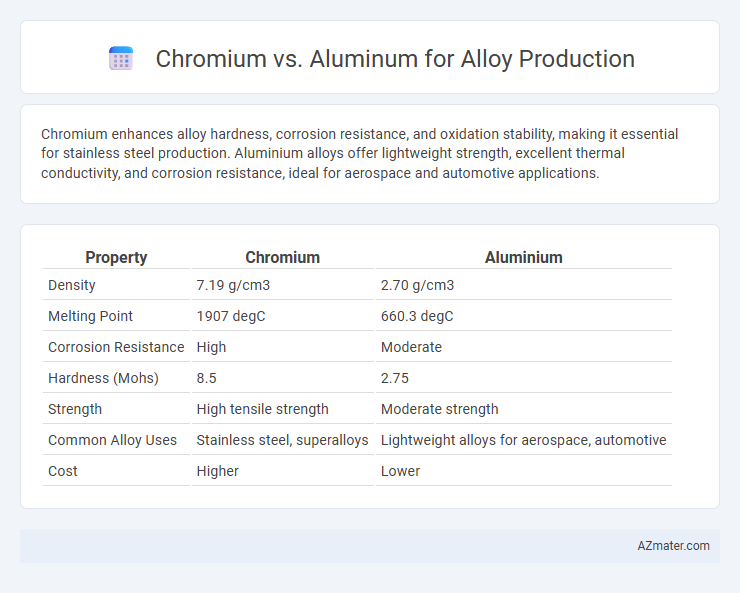Chromium enhances alloy hardness, corrosion resistance, and oxidation stability, making it essential for stainless steel production. Aluminium alloys offer lightweight strength, excellent thermal conductivity, and corrosion resistance, ideal for aerospace and automotive applications.
Table of Comparison
| Property | Chromium | Aluminium |
|---|---|---|
| Density | 7.19 g/cm3 | 2.70 g/cm3 |
| Melting Point | 1907 degC | 660.3 degC |
| Corrosion Resistance | High | Moderate |
| Hardness (Mohs) | 8.5 | 2.75 |
| Strength | High tensile strength | Moderate strength |
| Common Alloy Uses | Stainless steel, superalloys | Lightweight alloys for aerospace, automotive |
| Cost | Higher | Lower |
Introduction to Alloy Production
Chromium and aluminium are critical elements in alloy production, each offering distinct properties that influence performance and application. Chromium enhances hardness, corrosion resistance, and wear resistance, making it essential in stainless steel and superalloys. Aluminium contributes to lightweight alloys with excellent corrosion resistance and high strength-to-weight ratios, widely used in aerospace and automotive industries.
Overview of Chromium and Aluminium
Chromium is a hard, corrosion-resistant transition metal known for enhancing the strength, hardness, and oxidation resistance of alloys, especially stainless steel. Aluminium is a lightweight, ductile metal with excellent corrosion resistance and high thermal conductivity, widely used to improve weight reduction and corrosion protection in alloys. Both metals play crucial roles in alloy production, with chromium primarily contributing to durability and aluminium to weight efficiency.
Chemical Properties Comparison
Chromium and aluminium exhibit distinct chemical properties influencing their alloy production uses; chromium's high corrosion resistance and ability to form a stable oxide layer enhance durability and hardness in stainless steel alloys. Aluminium's lightweight nature, excellent oxidation resistance, and good thermal conductivity contribute to producing alloys prized for aerospace and automotive applications. The differing electronegativities and reactivities of chromium and aluminium determine their compatibility and strengthening effects in metallurgical processes.
Mechanical Strength and Durability
Chromium enhances alloy mechanical strength by improving hardness and resistance to wear, making it ideal for high-stress applications. Aluminium alloys offer superior durability through corrosion resistance and lightweight properties, ensuring longevity in harsh environments. Combining chromium with aluminium can create alloys that balance high strength with excellent durability for advanced engineering uses.
Corrosion Resistance Differences
Chromium enhances alloy corrosion resistance by forming a stable, adherent oxide layer that protects the metal from oxidation and environmental damage. Aluminium alloys naturally develop a thin oxide film providing effective corrosion resistance, particularly in atmospheric and marine environments. While chromium significantly improves stainless steel resistance to pitting and crevice corrosion, aluminium's oxide layer offers superior protection against general corrosion in lightweight applications.
Cost and Availability
Chromium is generally more expensive than aluminium due to its complex extraction and processing methods, impacting overall alloy production costs. Aluminium's abundant reserves and lower energy requirements for smelting make it a more cost-effective choice for large-scale alloy manufacturing. In terms of availability, aluminium is more widely accessible globally, whereas chromium supply is concentrated in fewer regions, affecting its price stability and procurement ease.
Environmental Impact and Sustainability
Chromium, essential in stainless steel alloys, offers excellent corrosion resistance but involves energy-intensive mining and processing with significant carbon emissions and toxic waste. Aluminium production demands high electricity but benefits from abundant recycling, significantly lowering its environmental footprint compared to primary extraction. Choosing aluminium alloys promotes sustainability through lightweight design and enhanced recyclability, while chromium alloys require careful management of environmental hazards linked to extraction and refining.
Industrial Applications
Chromium enhances corrosion resistance and hardness in alloys, making it essential in stainless steel production for industrial applications such as construction and automotive manufacturing. Aluminium alloys offer lightweight strength and excellent thermal conductivity, ideal for aerospace, transportation, and packaging industries. Combining chromium with aluminium in specific alloys can improve durability and resistance to wear in heavy machinery and structural components.
Processing and Manufacturing Techniques
Chromium enhances corrosion resistance and hardness in alloy production but requires precise high-temperature processing techniques such as vacuum induction melting to prevent oxidation and contamination. Aluminium alloys benefit from casting, extrusion, and rolling methods, where controlled cooling rates optimize grain structure and mechanical strength. Advanced manufacturing techniques like powder metallurgy and additive manufacturing enable precise composition control and microstructural refinement for both chromium and aluminium-based alloys.
Future Trends in Alloy Development
Chromium-enhanced alloys are increasingly favored for future alloy development due to their superior corrosion resistance and high-temperature stability, essential for aerospace and automotive industries. Aluminium-based alloys continue evolving with advancements in lightweight composites and nanotechnology, improving strength-to-weight ratios for electric vehicle applications. Emerging trends highlight hybrid alloys combining chromium and aluminium properties to optimize durability, sustainability, and cost-effectiveness in next-generation materials.

Infographic: Chromium vs Aluminium for Alloy Production
 azmater.com
azmater.com